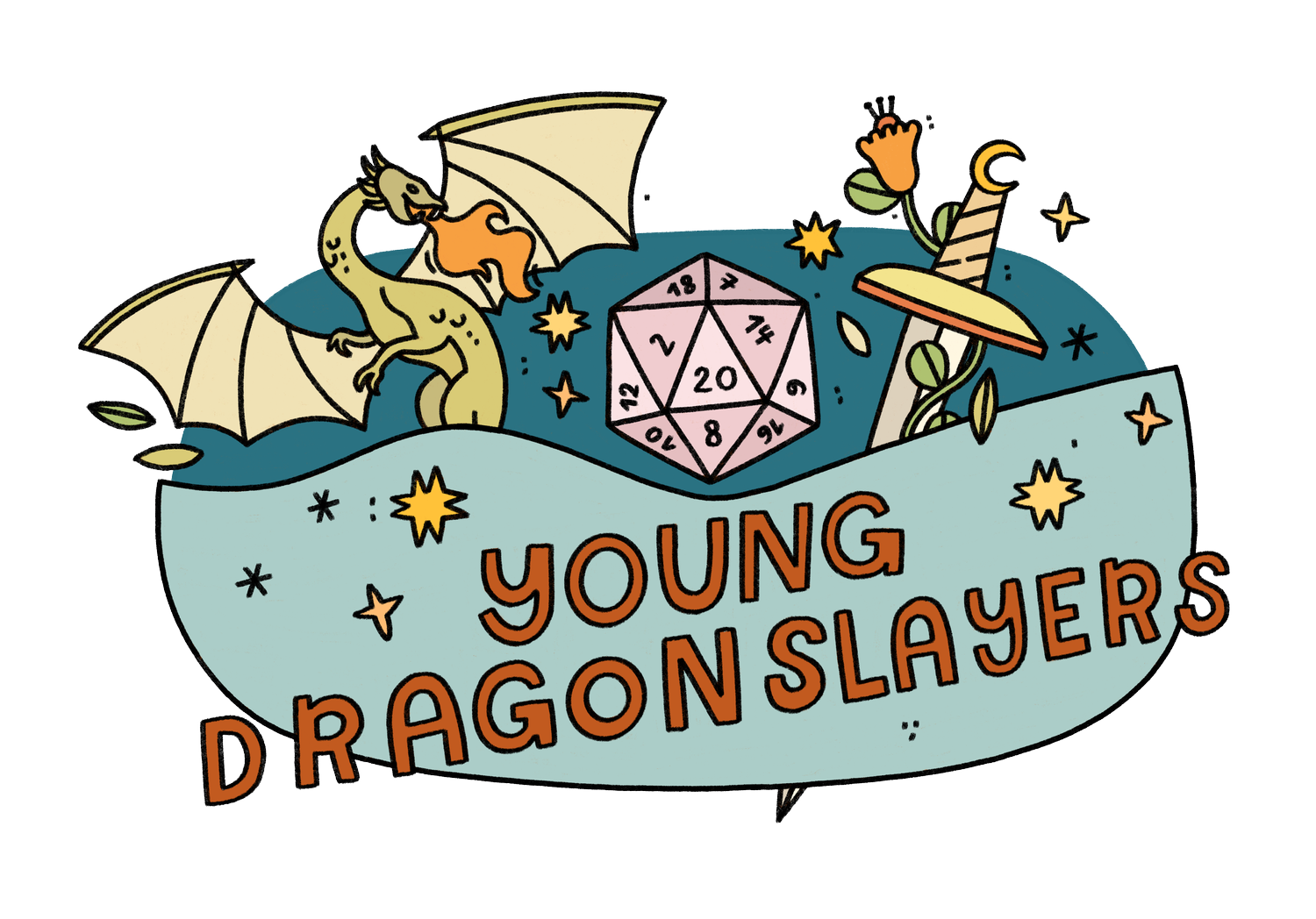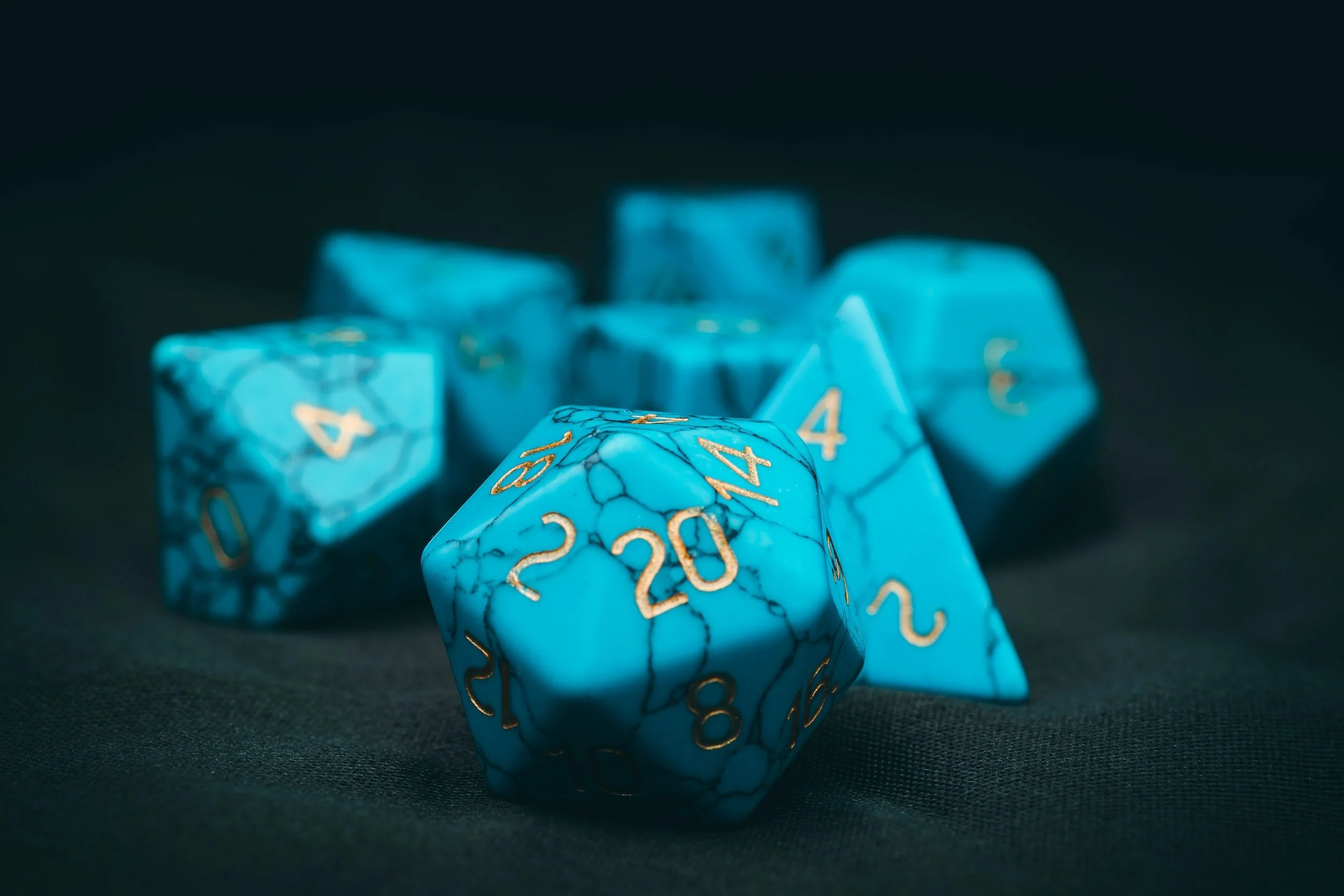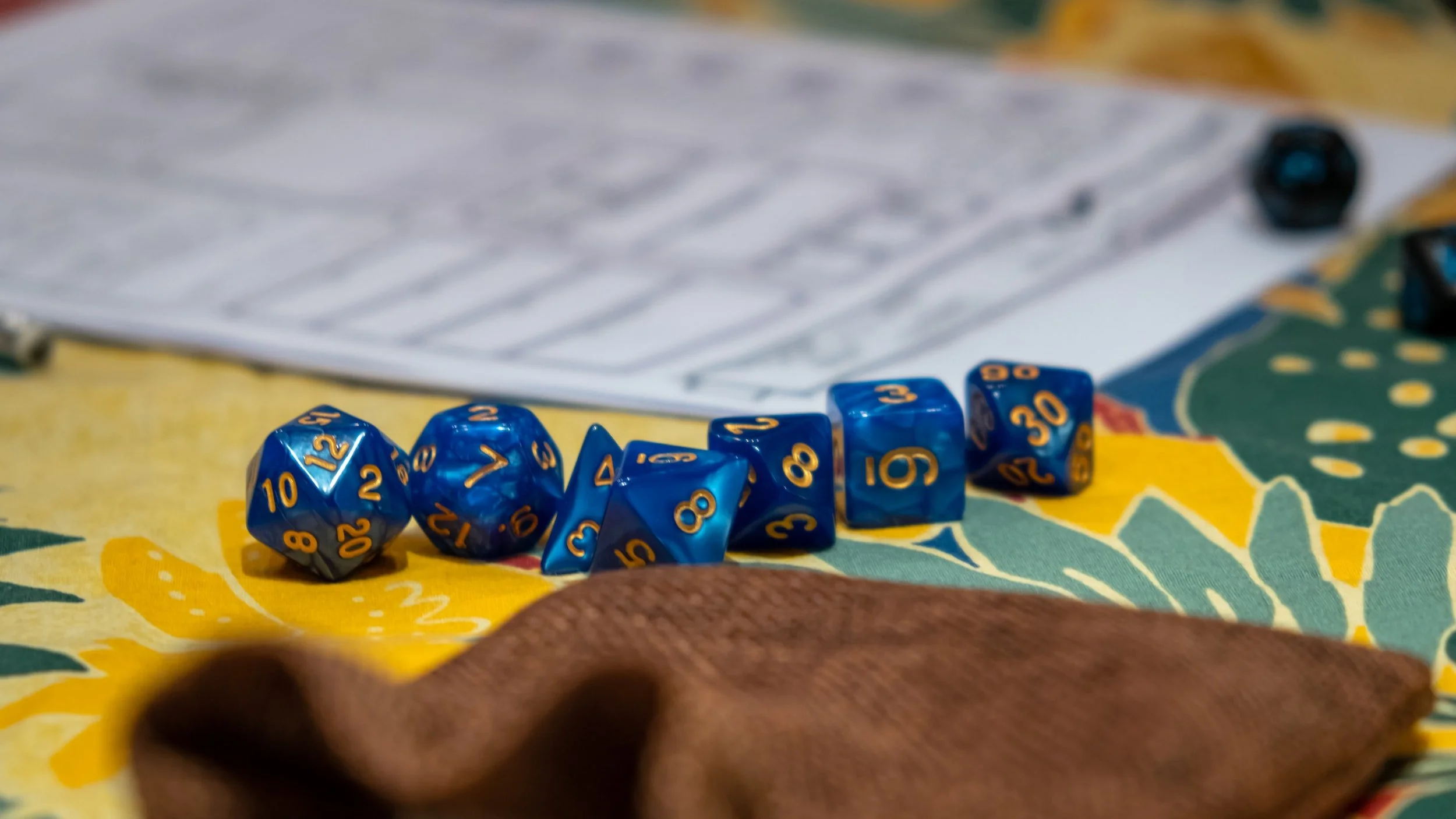Essential Role-Playing Game Terms Every Player Should Know
So, you’ve decided you want to play D&D. You’ve seen Stranger Things, maybe you’ve listened to an actual play podcast episode or two…you’re ready. Then you overhear your D&D-obsessed friend ranting about murder hobos and using unfamiliar role-playing game terms like RAW and RAI. You understand maybe half of what he’s saying. Are you really as prepared as you thought?!
Like most hobbies, D&D includes a lot of jargon and slang that has evolved over years of play. Some of this terminology may sound familiar from video games or other RPGs. Other words are unique to the world of Dungeons and Dragons.
Slang is helpful shorthand when you’re trying to get an idea across, and it’s also just fun to use. Kind of like an inside joke, slang is something you share with your fellow players that only you get. But it can also be intimidating!
We never want someone to get scared away from D&D just because they aren’t familiar with all the vocabulary words. So without further ado, here’s our RPG glossary of 40 common role-playing game terms we think every beginner should know.
General D&D And Role-Playing Game Terms
Before we get into more specialized categories, let’s start with the basics. Here are some general role-playing game terms that are helpful to know when you’re getting started with D&D. Some of these may appear familiar from other games, but it’s still helpful to know how this vocabulary gets used in Dungeons & Dragons.
TTRPG: A Tabletop Roleplaying Game, or TTRPG, is a style of game where players take on the roles of characters on a fictional world. These players describe what their characters would do out loud, and then use a set of rules to guide the story and figure out what happens next. D&D is the most popular and well-known TTRPG, but there are many others. Traditionally, these games were played sitting down at a table together, usually with pencil and paper in hand. These days, many TTRPGs can be played online, too.
DM or GM: The Dungeon Master, or DM, is the person who is running the game. They’re the leader who is in charge of setting up the story and providing problems and obstacles for players to solve. Lots of other roleplaying games have a leader like this, so you might also see people using the term GM, for Game Master, to describe this storyteller role.
PHB: The Player’s Handbook is a starter guide for all things D&D. It includes the basic rules of the game, lists of spells and weapons, and instructions on how to build a character. If you want to get started as a D&D player, this is a great book to have. You’ll often see the title shortened to “PHB.”
AC: AC stands for Armor Class. This is the number that determines how easy or hard it is to hit you when you’re in a fight. If a creature wants to attack you, they’re going to need to roll a number higher than your AC. The higher your AC, the tougher you are to hit.
HP: Like many other games, D&D uses hit points, or HP, to keep track of how much life force your character has remaining. If you get down to 0 HP, you fall unconscious and risk dying in the game. If you have a ton of HP, it’s not such a big deal to charge into combat and lose some—that’s just part of the game. But if you’re a delicate, low level character without many HP, maybe you want to be more careful.
RAW: RAW stands for Rules as Written. There’s a little debate about how the (many) rules of D&D should be followed. One side of the debate says that rules should be taken literally, exactly how they’re written in the D&D handbooks. RAW is all about the letter of the law. It’s a little more strict, but it can also help you keep the game from going totally off the rails.
RAI: RAI stands for Rules as Interpreted. This style of play gives DMs some wiggle room to adjust rules slightly if they think it makes sense for their particular game. This can be helpful because there are so many possible choices in D&D that sometimes a rule might not make perfect sense—or even if it does make sense, it might not be the most fun or interesting option. On the other hand, letting go of the rules too much might make characters overly powerful.
Rule of Cool: This is another way to handle rules in D&D. The Rule of Cool says that telling a good story is what matters most. If a character wants to do something that would make the story more fun or interesting, a DM following the Rule of Cool might allow it to happen even if it didn’t exactly follow the rules of the game. It’s still their call, though! We tend to follow this rule in our games at Young Dragonslayers™.
Session Zero: The first meeting of a new D&D campaign is often called Session Zero. These sessions are more about planning the game than playing the game. This is a great time to meet your fellow players, set ground rules, create characters, and talk about what kind of world your adventure should take place in.
Buff: A “buff” a term for something—usually a spell—that makes a character better in some way. When a character is affected by this spell, they become (at least temporarily) faster, stronger, smarter, more nimble…a slightly better version of themselves. These are good spells to cast on your party members or on yourself.
Debuff: The opposite of a buff, a debuff is a spell that makes a character somehow worse or weaker. It might slow a character down, reduce the amount of damage they can deal, or make it harder for them to sneak around unnoticed. These are usually the kinds of spells you want to try to cast on your enemies in combat.
Dungeon Crawl: In a dungeon crawl scenario, you and your fellow players must explore and fight your way through a complicated location filled with unknown dangers. It doesn’t have to be a literal dungeon: any mysterious place will do. You can expect twists and turns, traps, hidden monsters, and other tests of your skill. If you’re able to “clear” the dungeon by fighting off enemies and getting to the end, you’re usually rewarded with magical items, gold, or some other kind of loot.
TPK: Okay, we saved the bummer one for last. TPK stands for “total party kill” and it’s what you might get if your dungeon crawl goes horribly wrong. A TPK means that all your PCs died, and nobody was able to heal or revive anybody else. This could be due to facing a really powerful monster, going into an adventure unprepared, or just making a very unfortunate mistake. After a TPK, the players and DM can decide how they want to proceed: should they start over with new characters or find a different way to continue the story?
D&D Terms About Dice and Dice Rolls
A roll of the dice is how most big decisions in D&D get made. It adds an element of random luck to the game: no matter how good your plan is, you’re going to need the dice to agree with you. Here are some common D&D terms that have to do with dice and rolling.
D100, D20, D12, D10, D8, D6, D4: These are the names of the 7 dice used in D&D. You refer to the dice by the number of sides that it has…but the D100 doesn’t really have 100 sides, that would be a lot. It has 10. You’ll use the D20 for most things, and the others will come in handy for things like calculating damage from attacks.
Modifier: This is a number that you add or subtract from your dice roll in certain situations. If your character is an amazing actor, they might get to add +1 to their rolls when they perform. If they’re horribly clumsy, they might have a -2 when they try to do something sneaky.
Check: This is likely to be the most common kind of dice roll you’ll make in D&D. Any time you want to try something in the game where there’s no guarantee of success—trying to convince a shopkeeper to give you a discount, or sneaking past a sleeping guard, for instance—you’ll need to roll an ability or skill check to see how well you do. Your DM will have you roll a D20 and then add a modifier for whatever skill or ability most closely matches whatever you’re trying to do.
Initiative: This is a special kind of check you’ll do before starting combat. It’s based on your Dexterity modifier. Everyone who is involved in a fight has to take turns making attacks. If people went all at once, it would be too chaotic to figure out what happens when. Instead, the DM makes a list based on everyone’s initiative roll, from highest to lowest. This is called the initiative order, and it tells you when to take your turn. If your DM tells you to “roll for initiative,” you know stuff is about to go down.
Crit: Short for “critical hit",” this is the best result you can get when you roll a D20. In D&D, a 20 is excellent, a 1 is terrible, and everything else is somewhere in between. If you roll a 20, either by having the dice land on a 20 or rolling a lower number and then adding a modifier, that’s a crit.
Nat 20: This means that you straight-up rolled a 20 on your turn. No modifiers required. This generally means you automatically succeed at whatever you were trying to do—possibly in an exceptionally good way.
Dirty 20: This means your dice roll wasn’t originally a 20, but it added up to 20 once you added your modifier. Still really good, but not quite as magically lucky as a Nat 20.
Crit Fail: The opposite of a critical hit. This means you rolled your D20, you landed on a 1. Instead of automatically succeeding at whatever you were trying to do, you automatically fail, no matter how brilliant your plan was. And you might end up failing in a spectacular fashion.
Dice Jail: Rolling a lot of low numbers today? Blame the dice. Some players decide to punish dice that haven’t behaved well by sending them to time out or putting them in jail. Maybe they’ll have better luck with another set.
Role-Playing Game Terms for Characters and Character-Building
Building a D&D character is a pretty complex process, so it makes sense there are lots of vocabulary terms involved. Here are the main role-playing game terms you’ll need to know related to character creation, as well as some common character types you’re likely to encounter while playing D&D.
PC: PC stands for Player Character. PCs are the characters being roleplayed by you and the other members of your party. You’re able to control PCs, and they have main character energy.
NPC: NPCs, or Non Player Characters, are everybody else who makes up the D&D world you are playing in. Shopkeepers, quest givers, enemies, and random townspeople are all NPCs. They’re played by your Dungeon Master, and you’re not able to control them.
Alignment: This is a character building term that describes how nice or not-nice your character tends to be. D&D characters can be categorized as Good, Neutral, or Evil, which is pretty self-explanatory. But there’s a little extra twist: characters can also be “lawful,” meaning they’re traditional rule-followers, or “chaotic,” meaning they don’t like being told what to do. Robin Hood is a good example of a Chaotic Good character. Darth Vader is a classic Lawful Evil.
Stat: Every D&D character has their own personal strengths and weaknesses, and these are determined by their ability scores, also called stats. Characters have six stats: Strength, Dexterity, Constitution, Intelligence, Wisdom, and Charisma. How high or low of a number a character has in each of these stats determines how well or poorly they’re likely to do at pretty much any activity. Based on your ability score, you will either add or subtract a number, called a modifier, from your dice rolls in certain situations. Your modifier makes you more or less likely to succeed at a task, so stats are pretty important!
BBEG: Short for the Big Bad Evil Guy. Essentially, this is your main villain. The antagonist to your protagonist. The boss of the boss battle. Maybe you knew who this person was all along, or maybe at some point there’s a dramatic reveal of who the BBEG really is.
Tank: A tank is a type of character that is able to take tons of damage. They’re super tough, usually with a high AC and lots of hit points. Tanks help the party by getting out in front of weaker, squishier party members and absorbing attacks from enemies.
Meat Shield: Another nickname for a Tank-y character. These resilient characters are basically just human (or half-orc, or dragonborn) shields protecting the rest of the party.
Murder Hobo: A true agent of chaos, this is a slang term for a type of character that doesn’t care about anything or anyone. They just wander around committing crimes and killing people, including their other party members. While this level of chaos may sound tempting to some, most people don’t like playing with murder hobos. It’s hard to get anywhere in a story with a player who doesn’t care about quests, backstories, or anything else besides stealing your stuff.
Min-Maxing: Some players like to create characters with a story in mind. Others simply want to make the most powerful being imaginable. Min-maxing is one way to do this: you focus on making the stats your character is naturally good at as strong as possible, and ignore everything else. Some people like this style, since it sort of gives your character superpowers. Others don’t, because it can make the story less interesting if you’re only good at one thing, and you might end up way stronger than everyone else in your party.
Dump Stat: When you build a D&D character, you have to assign points to 6 different areas of skill, called stats, to decide what your character is good at. You only get so many points, which means that if you’re trying to make your character extra good at something, you’re going to end up with another stat that gets little to no love. Usually, it’s something your character naturally isn’t good at anyway. This stat that you don’t bother improving is called your dump stat.
OP: OP stands for “overpowered” in D&D and other games. It means that a character, weapon, or other item is way too strong compared to everything else in the game. This sounds cool at first, but it can end up “breaking” the game: if you are so powerful that there’s no challenge to any encounter, the game isn’t particularly fun to play—especially for everyone else who lacks those powers.
Terms to Describe D&D Players
Last but not least…let’s talk about you! These terms are all about the non-dice-roll stuff you can do as a player in D&D. You’ll find words having to do with roleplay, as well as quirks you might notice in your fellow players…or yourself.
Dice Goblin: Technically you only need one set of dice to play D&D (or none, if you’re playing online). But some players really love dice. They collect dice. They hoard dice, like….a goblin. If collecting dice and perhaps bringing an excessive number to your game brings you joy, you might be a dice goblin.
Rules Lawyer: You might get called a dice goblin affectionately, but if someone calls you a rules lawyer it’s usually not a great thing. There are a lot of rules in D&D, and rules laywers want to make sure everyone is following them exactly right. They might stop the game to argue with other players or even the DM about whether or not what they just did was correct.
Metagaming: Metagaming happens when someone uses their out-of-game knowledge to make decisions about what their character does in-game. You’re always going to know more about the game than your character does, and one of the challenges of roleplay is making sure that you are staying true to your character. You want to make the choice you think they’d make, based on their perspective and the knowledge they have. You might have heard the DM whisper a secret to another player, but your character definitely did not! Having them react as if they’d heard the secret too is a form of metagaming, and it makes the game less fun to play.
IC: This stands for “in character.” When you’re roleplaying, you’ll be speaking and doing things you wouldn’t normally do as yourself in the real world. Your character might even have beliefs, likes, or dislikes that are different from yours. Anything that you say or do while roleplaying is described as IC.
OOC: As you might have guessed, this stands for “out of character.” There are also times in D&D when you’ll be speaking as yourself: asking someone to clarify a rule, making a comment about the game, or just cracking a joke. Anything you say or do as your non-roleplaying self is described as OOC.
Above Table: Similar to OOC, “above table” refers to anything that happens during the game that isn’t direct gameplay. This could include talking about group rules, setting boundaries about stuff you do or don’t want to include in the campaign, or planning for future sessions. Some people also use this term to describe things like music and props that aren’t a required part of the game but can add to the fun and overall vibe.
On Table: When you’re actually playing the game rather than talking about the game, you’re “on table.” This is similar to IC in that it usually refers to things that are happening when you and your fellow adventurers are speaking and acting as your characters.
Railroading: The player and DM are supposed to work together to tell a story in D&D. The DM sets up the scene, and then the players decide how their character would react. Sometimes, a DM might (accidentally or on purpose) push the players to take the story in a certain direction, either by limiting the number of choices they have or by making something happen without giving the players much say in the matter. This can make players feel like no matter what they do, the story is going to follow a set path…kind of like a railroad.
Now That You Know The Basics, Come Play With Us!
Has our RPG glossary gotten you excited about playing D&D? We offer beginner-friendly games for kids and teens at Young Dragonslayers™, and we’d love to see you there. We think D&D is for everybody, whether you’re an experienced gamer or not, and we strive to be inclusive to players from all backgrounds.
One of the best ways to get started with us, especially if you’re new to the game, is by trying out an Intro Class. This one-time class is a great way to get a sense of what D&D is all about, especially when it comes to playing online. You’ll leave the class understanding the basic rules of the game and feeling more familiar with the software we use, so you can jump into a weekly game group feeling confident.
Want to learn more? Check out our FAQ page for answers to common questions about pricing and scheduling. Ready to play? Learn about all the ways you can get started, by clicking here or following the button below.






